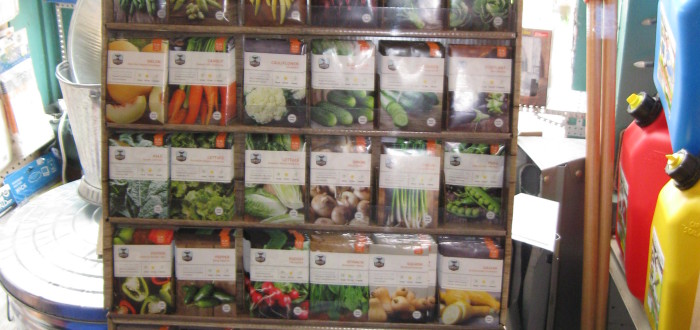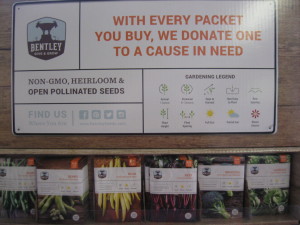Now that Spring is firmly arrived, it’s time to start thinking about your backyard garden. Actually it’s pretty late to get started as all hard-core gardeners have been planning all Winter. I always like to put in a vegetable garden in the backyard every year. It reminds me of my parent’s garden that we used to put in when I was little. They weren’t big vegetable gardeners, just a small plot for some tomatoes, but my Mom loved her flower gardens, and she had several scattered around our yard. I don’t do flowers (unless you count sunflowers) that is my wife’s realm. I just do vegetables.
While you can buy plants that are already started from local greenhouses, I always like to buy seeds and start the plants myself. We have a good selection of Bently seeds in the store. Bently is a small family grower that specializes in heirloom varieties and other old time garden favorites. Bently also has a seed giveaway program so that when you purchase a packet of seeds, they will give a packet away to a needy cause. These seed packets have all the basic information printed on them as to when and how to grow the plants, how long they take to mature, and what the produce will be like. Some seeds are planted directly in the soil, while others can be started indoors earlier, and then transplanted outside when it is warmer.
For growing vegetables in Ohio, the first thing you have to do is think about the seasons. In the Spring, there is always a chance of cold weather and frost, even though it may be warm during the day. Even though it is cold, you can still plant cold-tolerant crops, such as peas, lettuce, spinach and others. Just check the packages to make sure that they are marked for early planting. Most other crops will be hurt or killed by any frost, so you have to wait until the listed frost-free date for your area. Around here it is usually the beginning of June so the rest of your seeds can be planted then.
Once you get your garden established you can also grow multi-season crops. I have green onions and garlic, both of which will last over the Winter and will be ready in the Spring and Summer. I have these growing in raised beds (made out of old farm troughs) so I can cultivate the rest of the garden around them without having to disturb them. Once the garden is turned over, I put up a fence around it to keep the rabbits and groundhogs at bay. Deer can also be a nuisance, but I have noticed that even though they can easily leap over a small fence, they usually won’t jump into a small garden, maybe because they are afraid that they won’t be able to get out again.
Getting the garden planted though is just the beginning, you still have to thin the seedlings and keep it weeded. Water usually isn’t a problem until the end of the Summer when you will have to keep an eye on your soil to make sure that it doesn’t get too dry. Then in the late Summer and Fall you can start picking the fruits (or vegetables) of you labor.



